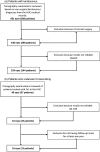The HUC progression score: A new method for determining KERATOCONUS progression
- PMID: 38632934
- PMCID: PMC11295412
- DOI: 10.1177/11206721241247587
The HUC progression score: A new method for determining KERATOCONUS progression
Abstract
Purpose: To establish new criteria for the progression of keratoconus, taking into account a Pentacam HR (high resolution) tomographeŕs repeatability limit.
Methods: This is a retrospective observational study, including 224 eyes in 154 patients diagnosed with keratoconus and patients treated with crosslinking, with a follow-up of at least one year, in which the new progression score of the Cruces University Hospital for keratoconus progression was analyzed. This score takes into account: maximum keratometry, thinnest corneal thickness, maximum posterior elevation, vertical coma and RMS of high order aberrations, all based on the tomographer repeatability limit. The effectiveness or not of crosslinking was determined.
Results: The Receiver Operating Characteristics (ROC) curves obtained in our validation met the criteria by being far from the reference diagonal. Moreover, young patients are more likely to have keratoconus that progresses, and the percentage of patients that showed progression was 14.3% of the eyes studied, with the most advanced keratoconus showing the least progression. Taking into account the new progression score of the Cruces Hospital, we would have indicated crosslinking in 2 eyes only and we observed that none progressed one year after treatment.
Conclusions: The the new progression score of the Cruces University Hospital is a method based on the real repeatability limit for keratoconic eyes. Moreover, it is easy to interpret and can be implemented with Pentacam software. It provides a numerical value that evaluates both the anterior and posterior surfaces of the cornea and corneal aberrations in the evolution of keratoconus.
Keywords: CORNEA / EXTERNAL DISEASE; corneal degenerations < CORNEA / EXTERNAL DISEASE; examination techniques: corneal topography/Keratometry < CORNEA / EXTERNAL DISEASE; examination techniques: pachimetry < CORNEA / EXTERNAL DISEASE; examination techniques < CORNEA / EXTERNAL DISEASE.
Conflict of interest statement
Declaration of conflicting interestsThe authors declared no potential conflicts of interest with respect to the research, authorship, and/or publication of this article.
Figures
Similar articles
-
Influence of the beam profile crosslinking setting on changes in corneal topography and tomography in progressive keratoconus: Preliminary results.J Cataract Refract Surg. 2018 Jun;44(6):718-724. doi: 10.1016/j.jcrs.2018.03.025. Epub 2018 May 31. J Cataract Refract Surg. 2018. PMID: 29778454
-
Optical Performance of the Cornea One Year Following Keratoconus Treatment with Corneal Collagen Cross-Linking.Curr Eye Res. 2018 Dec;43(12):1415-1421. doi: 10.1080/02713683.2018.1501802. Epub 2018 Jul 30. Curr Eye Res. 2018. PMID: 30012019
-
Assessment of the Predictive Ability of Theranostics for Corneal Cross-linking in Treating Keratoconus: A Randomized Clinical Trial.Ophthalmology. 2024 Dec;131(12):1403-1415. doi: 10.1016/j.ophtha.2024.06.012. Epub 2024 Jun 20. Ophthalmology. 2024. PMID: 38908553 Clinical Trial.
-
[KERATOCONUS: DIAGNOSIS AND INNOVATIONS].Harefuah. 2025 Jan;164(1):39-45. Harefuah. 2025. PMID: 39931019 Review. Hebrew.
-
Pediatric keratoconus.Surv Ophthalmol. 2025 Mar-Apr;70(2):296-330. doi: 10.1016/j.survophthal.2024.10.003. Epub 2024 Oct 12. Surv Ophthalmol. 2025. PMID: 39396644 Review.
References
-
- Henriquez MA, Izquierdo L, Bernilla C, et al. Riboflavin/ultraviolet A corneal collagen cross-linking for the treatment of keratoconus: visual outcomes and Scheimpflug analysis. Cornea 2011; 30(3): 281–286. - PubMed
-
- Hashemi H, Seyedian MA, Miraftab M, et al. Corneal collagen cross-linking with riboflavin and ultraviolet a irradiation for keratoconus: long-term results. Ophthalmology 2013; 120(8): 1515–1520. - PubMed
-
- Poli M, Cornut P-L, Balmitgere T, et al. Prospective study of corneal collagen cross-linking efficacy and tolerance in the treatment of keratoconus and corneal ectasia: 3-year results. Cornea 2013; 32(5): 583–590. - PubMed
-
- Vinciguerra R, Romano MR, Camesasca FI, et al. Corneal cross-linking as a treatment for keratoconus. Ophthalmology 2013; 120(5): 908–916. - PubMed
-
- Caporossi A, Mazzotta C, Paradiso AL, et al. Transepithelial corneal collagen crosslinking for progressive keratoconus: 24-month clinical results. J Cataract Refract Surg 2013; 39: 1157–1163. - PubMed
Publication types
MeSH terms
Substances
LinkOut - more resources
Full Text Sources
Miscellaneous



